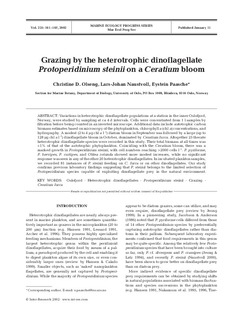| dc.description.abstract | Variations in heterotrophic dinoflagellate populations at a station in the inner Oslofjord, Norway, were studied by sampling at ca 4 d intervals. Cells were concentrated from 1 l samples by filtration before being counted in an inverted microscope. Additional data include autotrophic carbon biomass estimates based on microscopy of the phytoplankton, chlorophyll a (chl a) concentrations, and hydrography. A modest (2 to 4 µg chl a l-1) diatom bloom in September was followed by a large (up to 128 µg chl a l-1) dinoflagellate bloom in October, dominated by Ceratium furca. Altogether 25 thecate heterotrophic dinoflagellate species were recorded in this study. Their total biomass at all times was <1% of that of the autotrophic phytoplankton. Coinciding with the Ceratium bloom, there was a marked growth in Protoperidinium steinii, with cell numbers reaching >2000 cells l-1. P. pyriforme, P. brevipes, P. curtipes, and Oblea rotunda showed more modest increases, while no significant response was seen in any of the other 20 heterotrophic dinoflagellates. In incubated plankton samples, we recorded 81 instances of P. steinii feeding on C. furca or on other dinoflagellates. Our study confirms previous laboratory findings suggesting that P. steinii belongs to the limited selection of Protoperidinium species capable of exploiting dinoflagellate prey in the natural environment. | no_NO |
